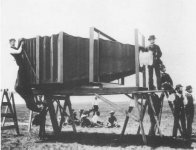You are using an out of date browser. It may not display this or other websites correctly.
You should upgrade or use an alternative browser.
You should upgrade or use an alternative browser.
The best camera ever for street photography. Period.
- Thread starter iamzip
- Start date
- Latest activity Latest activity:
- Replies 18
- Views 5K
Rayt
Nonplayer Character
I agree this would be the ideal camera for literally street photography. Eugene Smith actually did shoot the streets in his Pittsburg project.
iamzip
Ambitious, but rubbish
Yes, if you could hoist that thing up in a helicopter you could probably get a shot of an entire city detailed enough to use as a map. I can't beleive they actually built that thing.
PhotoMat
Well-known
And I'm sure that it has a whisper quiet shutter -- because it's 10 feet up in the air!
W
wlewisiii
Guest
You have to remember - when they used glass plates, there were no enlargers, only contact prints. If you needed a large print, for any reason, you used a large camera.
It is no longer the biggest ever. ISTR that an aircraft hanger was converted into a camera last year and the rear wall was covered in a cloth treated to become a direct positive print.
William
It is no longer the biggest ever. ISTR that an aircraft hanger was converted into a camera last year and the rear wall was covered in a cloth treated to become a direct positive print.
William
iamzip
Ambitious, but rubbish
Yes, that's what I had read. If you wanted a big picture, you had to have a big camera. And even though Guiness states that the airplane hanger is the biggest camera ever, does it really count? I mean, you can only take one picture with it - the picture of what's directly across from the hangar. The Mammoth is certainly more impressive, IMHO.
marke
Well-known
If it were painted black, it might be more stealthy. 😛
rogue_designer
Reciprocity Failure
If it were painted black, it might be more stealthy. 😛
Yeah, but I hope they didn't scale up the red dot too... or you'll be blinding people with it.
pachuco
El ****
If it were painted black, it might be more stealthy. 😛
LOL!! Or, black tape if you can find enough! 😀
infrequent
Well-known
removing that bottom plate and loading film must be a PITA.
iamzip
Ambitious, but rubbish
removing that bottom plate and loading film must be a PITA.
Yes, imagine if every time you wanted to take a picture you had to load a 4.5x8 foot glass plate into your camera...
marke
Well-known
Imagine what the full scale version of a Nocti on it would look like! 😱
amateriat
We're all light!
Darren Abate
Professional Shooter
Yeah, but I hope they didn't scale up the red dot too... or you'll be blinding people with it.
Dammit! You beat me to the red dot punchline!
:bang:
rbsinto
Well-known
- Local time
- 8:55 PM
- Joined
- Dec 23, 2006
- Messages
- 1,597
What? No motor drive?
LeicaVirgin
Newbie
This reminded me of a room-sized polaroid camera that I heard about a few years ago. It must have taken at least two people to shake the print! 😛
rbiemer
Unabashed Amateur
Here's what I found on Answers.com:
Rob
And I recall reading somewhere that the lens in the picture above was composited in, apparently that photo of the camera was taken before the lens was mounted.Mammoth camera, a huge camera custom designed by the Chicago photographer and inventor George R. Lawrence in 1900 in order to photograph a complete train owned by the Chicago & Alton Railway. It was 6.1 m (20 ft) long when fully extended and, with its 227 kg (500 lb) plate holder, weighed 633 kg (1, 400 lb). The plate itself measured 2.44 × 1.37 m (8 × 4 1/2 ft). A single, 2 1/2-minute exposure of the train was made, and three contact prints sent to the Exposition Universelle in Paris, where the picture won the ‘Grand Prize of the World for Photographic Excellence’.
Rob
Andrew Sowerby
Well-known
Just once I'd like to win the Grand Prize of the World for Photographic Excellence.
T
tedwhite
Guest
Pity they still don't award that prize. Or do they?
Similar threads
- Replies
- 0
- Views
- 219
- Replies
- 111
- Views
- 8K


